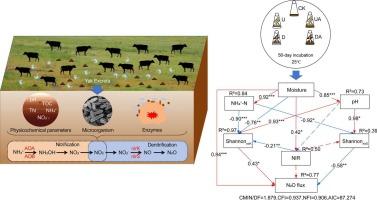Yak excreta increases the soil N2O emissions by regulating denitrifying bacterial diversity in the alpine marsh, Southwest China
IF 5
2区 农林科学
Q1 SOIL SCIENCE
引用次数: 0
Abstract
The impact of livestock excreta on soil N₂O emissions has attracted increasing attention in recent years. However, the mechanism of yak excreta on N2O emissions of marsh soil has not been elucidated. A laboratory incubation experiment was undertaken to assess the impact of yak excreta inputs on soil N₂O emissions in the alpine marsh and ascertain the crucial distinctions between the consequences of adding yak dung (DA) and urine (UA). The N2O emission flux and cumulative N2O emissions from UA and DA were markedly elevated compared with those of the experimental reference cohort during the entire experimental period. While the overall emissions of N2O from dung were found to surpass those from urine (P < 0.05), after their addition to soils, the cumulative N2O emission of UA was significantly superior to that of DA (P < 0.05). Dung input exerted a negative priming effect on N2O emissions in marsh soil, while urine input had a positive priming effect. The addition of yak excreta altered soil pH, moisture, NH4+-N and affected the diversity of nirK and nirS, as well as the activities of urease, N-Acetyl-β-glucosidase (NAG), nitrate reductase, and nitrite reductase (P < 0.05). It can be further found from the results of the structural equation model that the pH, moisture, NH4+-N, nitrite reductase activity, and Shannon indices of nirK and nirS were the main predictors for regulating N2O emissions in marsh soil. These findings offer essential insights into the mechanisms underlying N2O emissions associated with the application of yak manure in marsh soil, highlighting the vital function of denitrifying bacteria in alpine marsh ecosystems.

牦牛粪便通过调节高寒沼泽反硝化细菌多样性增加土壤N2O排放
近年来,家畜排泄物对土壤N₂O排放的影响越来越受到人们的关注。然而,牦牛粪便对沼泽土壤N2O排放的影响机制尚不清楚。通过室内培养试验,评估了牦牛粪便输入对高寒沼泽土壤N₂O排放的影响,并确定了添加牦牛粪便(DA)和尿液(UA)的结果之间的关键区别。在整个实验期间,UA和DA的N2O排放通量和累积N2O排放量均显著高于实验参考队列。粪中N2O的总排放量高于尿中(P < 0.05),而添加到土壤中后,UA的累积N2O排放量显著优于DA (P < 0.05)。粪便输入对沼泽土壤N2O排放具有负启动效应,而尿液输入对沼泽土壤N2O排放具有正启动效应。牦牛排泄物的添加改变了土壤pH、水分、NH4+-N,影响了土壤中nirK和nirS的多样性,以及脲酶、n -乙酰-β-葡萄糖苷酶(NAG)、硝酸盐还原酶和亚硝酸盐还原酶的活性(P < 0.05)。从结构方程模型的结果可以进一步发现,pH、水分、NH4+-N、亚硝酸盐还原酶活性以及nirK和nirS的Shannon指数是调节沼泽土壤N2O排放的主要预测因子。这些发现为了解沼泽土壤中施用牦牛粪相关的N2O排放机制提供了重要见解,突出了反硝化细菌在高寒沼泽生态系统中的重要功能。
本文章由计算机程序翻译,如有差异,请以英文原文为准。
求助全文
约1分钟内获得全文
求助全文
来源期刊

Applied Soil Ecology
农林科学-土壤科学
CiteScore
9.70
自引率
4.20%
发文量
363
审稿时长
5.3 months
期刊介绍:
Applied Soil Ecology addresses the role of soil organisms and their interactions in relation to: sustainability and productivity, nutrient cycling and other soil processes, the maintenance of soil functions, the impact of human activities on soil ecosystems and bio(techno)logical control of soil-inhabiting pests, diseases and weeds.
 求助内容:
求助内容: 应助结果提醒方式:
应助结果提醒方式:


